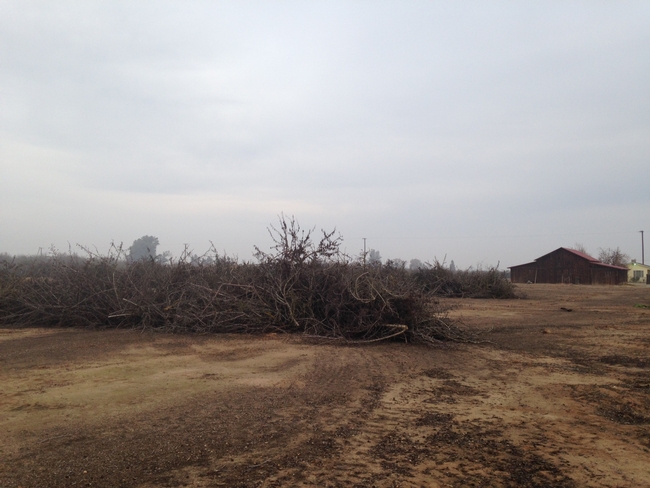
Holtz has been pioneer in ag burn alternatives throughout his 26-year-career with UCCE, and going back still further on his family almond farm near Modesto. Beginning in the early 1990s, Holtz and his father experimented with chipping almond prunings instead of burning them, long before air quality regulations required wide implementation of the practice.
When Holtz heard a four-acre stone fruit orchard was slated for removal at the UC Kearney Agricultural Research and Extension Center in Parlier seven years ago, he took the opportunity to study the impact of grinding up and incorporating the whole trees before planting a new orchard.
“When an orchard is pushed out, there is about 100 tons per acre of organic matter that is taken out of the system,” Holtz said. “My previous research showed positive results from organic matter. Our San Joaquin Valley soils are typically critically low in organic matter. Why remove it if it is good for the soil?”
A local company was contracted to grind up and incorporate the trees using an Iron Wolf, essentially a 50-ton rototiller, in selected research plots. (See video below.) At first, Holtz was concerned that the Iron Wolf left “firewood-sized” chucks of wood in the plots, pieces much larger than he had studied before in his wood chipping research. But the worry turned out to be unfounded.
In comparison plots, trees were pushed together and burned. The ashes later were spread out on the soil. All the plots were fertilized at the normal rate.
Over the years, Holtz has compared laboratory analyses of the nutrients available to the trees in the soil and nutrients in the leaves. Initially, the burn treatments had more nutrients available. The second year, nutrient availability was about equal. Leaf analyses in the third year began to show a higher level of nutrients in the leaves of trees growing in the area where old trees had been ground up and incorporated. In the fifth and sixth years, Holtz didn't see any differences in growth, but data suggests slightly higher yields where the trees were ground up.
“A lot of growers feared if we added that much carbon to the soil, the microbes breaking down the organic matter would tie up nitrogen and the trees would be stunted,” Holtz said. “But the research results suggest that the trees will do just as well or better in the presence of the additional organic matter.”
One potential barrier to grinding up old trees is the cost. Holtz said the Iron Wolf treatment cost $800 per acre and it is not readily available in the San Joaquin Valley. Burning is nearly cost-free for the farmer, but contributes to air pollution and is highly regulated.
Another option for almond farmers preparing to remove an orchard and replant is employing a large tub grinder, which leaves much finer particles of wood than the Iron Wolf, is more readily available but more expensive. Holtz said he hopes that growers in the future will receive incentives to grind up their orchards and incorporate the wood chips into their soils before they plant a second- or third-generation orchard.
“I'm trying to find growers who would be interested in trying this approach to conduct on-farm research,” Holtz said.
In the video below, the Iron Wolf grinds up whole trees and incorporates the organic matter into the soil:
An initiative to enhance competitive and sustainable food systems is part of the UC Division of Agriculture and Natural Resources Strategic Vision 2025.